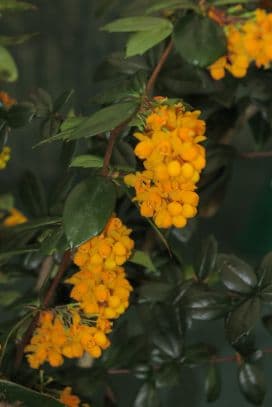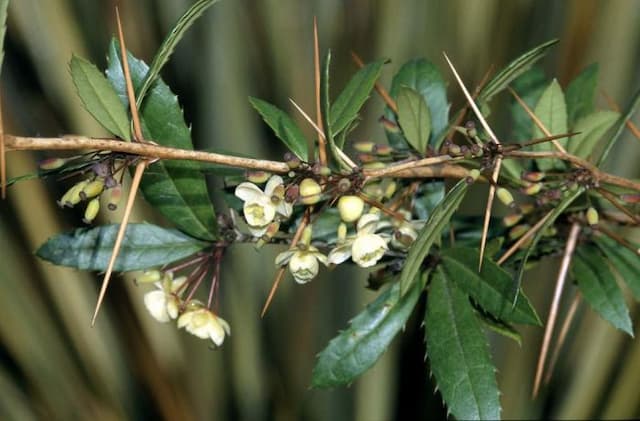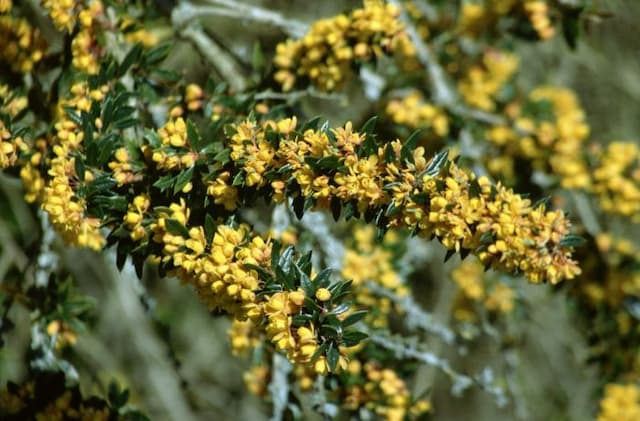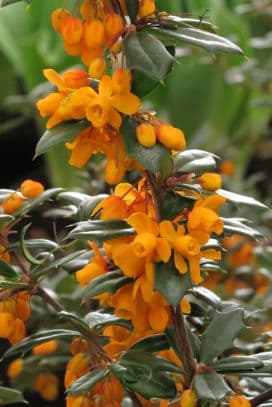Oregon grape 'Cantab' Mahonia × lindsayae 'Cantab'

ABOUT
'Cantab' is a stoutly branched, evergreen shrub with large, arching, spiny leaves up to 60cm long, with up to 15 leaflets, some of which turn red in winter. The pale lemon, scented flowers are produced in lax sprays in late autumn and early winter
About this plant
 Names
NamesFamily
Berberidaceae
Synonyms
Cantab Mahonia
Common names
Mahonia × lindsayae 'Cantab'.
 Characteristics
CharacteristicsLife cycle
Perennials
Foliage type
Evergreen
Color of leaves
Green
Flower color
Yellow
Height
5 feet (1.5 meters)
Spread
4 feet (1.2 meters)
Plant type
Shrub
Hardiness zones
7
Native area
Hybrid
Benefits
 General Benefits
General Benefits- Aesthetic Appeal: Adds beauty to gardens with its vibrant yellow flowers and purplish-blue berries.
- Year-Round Interest: Evergreen foliage ensures visual appeal in all seasons.
- Wildlife Attraction: Produces flowers and berries that attract birds and beneficial insects.
- Low Maintenance: Requires minimal care once established, making it suitable for busy gardeners.
- Drought Tolerance: Once established, it has good resistance to drought conditions.
- Shade Tolerance: Can thrive in partially shaded areas where other plants might struggle.
- Soil Adaptability: Adapts to a range of soil types, though it prefers well-drained soils.
- Privacy Screening: Dense growth can provide privacy when planted as a hedge or screen.
- Architectural Interest: The plant's structured form can add architectural interest to garden designs.
- Erosion Control: Its root system helps stabilize soil on slopes, reducing erosion.
 Medical Properties
Medical PropertiesThis plant is not used for medical purposes.
 Air-purifying Qualities
Air-purifying QualitiesThis plant is not specifically known for air purifying qualities.
 Other Uses
Other Uses- Photography Background: The evergreen foliage and vibrant yellow flowers of Oregon grape can provide a stunning, natural backdrop for photography, particularly macro and nature photography.
- Dye Production: The berries of the Oregon grape contain a natural pigment that can be used to produce plant-based dyes for fabric and yarn.
- Educational Use: Oregon grape can be used in educational settings such as schools and botanical gardens to teach students about native plants and their ecological roles.
- Erosion Control: The sturdy, spreading nature of Oregon grape makes it a good candidate for use in erosion control projects on slopes and other vulnerable areas.
- Habitat Creation: Oregon grape can be planted to create habitats for local wildlife, providing food in the form of berries and shelter within its dense foliage.
- Garden Borders: The Oregon grape's compact growth habit and attractive foliage can be utilized to define edges and borders in landscaped gardens.
- Winter Interest: In areas with dreary winters, the evergreen leaves and bright berries of Oregon grape can provide much-needed color and interest during the colder months.
- Landscape Restoration: Oregon grape can be included in rewilding and landscape restoration projects to help return an area to its natural, pre-disturbed state.
- Winter Bouquets: Cut stems of Oregon grape can be included in floral arrangements, particularly winter bouquets, adding a touch of natural beauty with their holly-like leaves and berries.
- Fragrance Garden Component: While not known for strong fragrance, the subtle scent of Oregon grape flowers can contribute to a multi-sensory experience in a garden designed for fragrance.
Interesting Facts
 Feng Shui
Feng ShuiThe Mahonia is not used in Feng Shui practice.
 Zodiac Sign Compitability
Zodiac Sign CompitabilityThe Mahonia is not used in astrology practice.
 Plant Symbolism
Plant Symbolism- Persistence: The Mahonia × lindsayae 'Cantab', commonly known as the Lindsay's Mahonia, is a hybrid plant that thrives in a variety of conditions, symbolizing the resilience and determination to persist through challenges.
- Protection: With its spiny leaves reminiscent of holly, Lindsay's Mahonia is often associated with protection and defense, implying the ability to safeguard oneself or others from harm.
- Healing: Mahonia plants have been used in traditional medicine, and their inclusion in gardens can symbolize the healing nature of both the environment and the human spirit.
- Beauty in Adversity: The Lindsay's Mahonia blooms with vibrant yellow flowers in the harsher seasons of late winter to early spring, symbolizing the ability to find or create beauty even in difficult circumstances.
 Water
WaterThe Oregon grape 'Cantab' prefers evenly moist soil, particularly during the growing season in spring and summer, but it also tolerates dry periods once established. Water this plant thoroughly once a week, providing about 1 to 1.5 gallons of water for each watering session, ensuring the soil is damp but not waterlogged. In hot weather, you may need to water more frequently to maintain moisture levels, but reduce watering in winter when the plant is dormant. Check the top inch of soil for dryness as a guide for when to water next, tailoring the schedule to your specific climate conditions.
 Light
LightOregon grape 'Cantab' thrives in partial shade to full sun, favoring a spot that receives morning sunlight and shade during the hottest part of the day. An ideal location would provide bright, indirect light which promotes healthy growth without the risk of leaf scorch that can occur with too much intense sunlight. This plant is adaptable and can handle varying light conditions, making it versatile for garden placement.
 Temperature
TemperatureOregon grape 'Cantab' is hardy and can withstand temperatures as low as 0-10°F for brief periods, but it does best in areas where winter temperatures stay above 20°F. Ideal growth temperatures are between 50°F and 75°F. This plant is suitable for USDA hardiness zones 5 through 9 and can adapt to a variety of climates within those zones.
 Pruning
PruningPruning Oregon grape 'Cantab' is mainly done to maintain shape, remove dead or damaged wood, and encourage fresh growth. Prune in late winter or early spring before new growth begins. Cut back up to one-third of the oldest stems to ground level to stimulate new shoots. Lightly trim the plant after flowering to keep it neat, if necessary. Pruning every couple of years is typically adequate for this low-maintenance plant.
 Cleaning
CleaningAs needed
 Soil
SoilLindsay's Mahonia prefers a moist, well-draining soil mix composed of loam, peat, and sand, which facilitates adequate drainage and root aeration. A slightly acidic to neutral pH of 5.5 to 7.0 is most suitable for this hybrid Mahonia. Incorporating organic matter like compost can also benefit the plant's health and growth.
 Repotting
RepottingLindsay's Mahonia should generally be repotted every 2-3 years or when it becomes root-bound. The best time for repotting is in the spring or early summer, which allows the plant to establish in its new container before the winter. Ensure the new pot is only slightly larger than the old one to prevent waterlogging.
 Humidity & Misting
Humidity & MistingLindsay's Mahonia thrives in moderate to high humidity levels, ideally ranging from 50% to 60%. While it can tolerate lower humidity, providing a more humid microclimate will support its healthy growth, especially if the indoor air is particularly dry.
 Suitable locations
Suitable locationsIndoor
Place Lindsay's Mahonia in bright, indirect light and keep soil moist.
Outdoor
Plant Lindsay's Mahonia in partial shade; shelter from harsh sun and wind.
Hardiness zone
7-9 USDA
 Life cycle
Life cycleMahonia × lindsayae 'Cantab', commonly known as Lindsay's Mahonia, begins its life as a seed, requiring a period of cold stratification to break dormancy before germination occurs. Once the seed germinates in late winter to early spring, a seedling emerges, developing a root system and juvenile foliage. As the plant matures, it grows into a bushy evergreen shrub with pinnate, spiky leaves. During the late fall to winter, it produces vibrant yellow flowers which, if successfully pollinated, develop into blue-black berries that are dispersed by birds and other wildlife. Over the years, the shrub will continue to grow and may require pruning to maintain its shape and health. Eventually, as with all perennials, Lindsay's Mahonia will reach the end of its life cycle, at which point it may die back or require propagation to continue its lineage.
 Propogation
PropogationPropogation time
Spring-Early Summer
The Mahonia × lindsayae 'Cantab', commonly referred to as Lindsay's Mahonia or Cantab Mahonia, is typically propagated through semi-hardwood cuttings. This method is most effective when performed in late summer. To propagate by cuttings, one should select healthy, semi-ripe stems and cut a section around 4 to 6 inches (10 to 15 centimeters) long with several leaf nodes. The cut end of the stem should be dipped in rooting hormone to encourage root growth. The cutting is then planted in a well-draining potting mix, ensuring at least two nodes are buried where roots will form. The pot should be kept moist and in indirect light until roots establish, which can be checked by gently tugging on the cutting after a few weeks to feel for resistance, indicating root growth.







![Japanese barberry [Bonanza Gold]](/_next/image?url=https%3A%2F%2Fplants-admin.emdemapps.com%2Fimages%2Fplants%2F%2Fimages%2F604b5385e413f.png&w=640&q=75)

